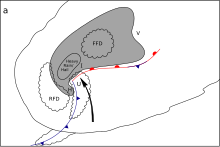Hook echo
Heiser, and S.G. Bigler determined that a destructive tornado had occurred in the geographical location which corresponded with the "six-shaped" echo seen on radar.Prominent severe storm researcher Ted Fujita also documented hook echoes with various supercell thunderstorms which occurred on 9 April 1953 - the same day as the Huff et al.[9] Fulks analyzed wind velocity data from Doppler weather radar units which were installed in Central Oklahoma in 1960.By detecting hydrometeors moving toward and away from the radar location, the relative velocities of air flowing within different parts of a storm are revealed.HP supercells instead often have a high reflectivity pendant or front flank notch (FFN), appearing like a "kidney bean" shape.Prior to 2008, NEXRAD had a range resolution of 1,000 meters, while the processes which lead to a hook echo happen on a smaller scale.



1999 Bridge Creek-Moore tornadoweather radarsupercellthunderstormsmesocyclonereflectivitytornadoNational Weather Servicetornado vortex signaturetornado warningKansas EF2 tornadoChampaign–Urbana, Illinoiselectrical engineerprecipitationmeteorologistssevere stormTed Fujitawind velocityCentral Oklahomawind shearproduce tornadoesbounded weak echo regionrear flank downdraftDoppler on WheelsLa Grange, WyomingVORTEX2debris ballNEXRADhydrometeorsSouthern United StatesBow echoLemon techniqueConvective storm detectionBibcodeWeatherwiseThe News-Gazette